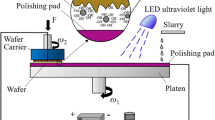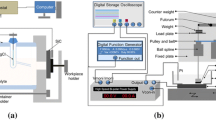Abstract
A novel innovative catalytic abrasive cluster prepared in the laboratory was used for tribochemical mechanical polishing of silicon carbide wafers, and the polishing performance of catalytic abrasive cluster was characterized. Comparison of tribochemical mechanical polishing using Al2O3 abrasive, iron-based white corundum mixed abrasive and catalytic abrasive cluster to study the material removal mechanism of catalytic abrasive cluster on silicon carbide workpieces. Quanta 200 scanning electron microscope (SEM) and Oxford INCA 250 energy-dispersive spectrometer (EDS) and x-ray diffraction (XRD) diffractometer were used to observe the surface, analyze the elements, and determine the composition of silicon carbide workpiece after tribochemical mechanical polishing. The experimental result shows that oxygen is produced in the tribochemical mechanical polishing of silicon carbide by catalytic abrasive cluster, which makes the silicon carbide surface generates SiO2 shear film that is easy to be removed. Comparing with iron-based white corundum mixed abrasive and Al2O3 abrasive, the catalytic abrasive cluster has better processability for 6H-SiC, and the material removal rate can reach to 42.928 nm/min.











Similar content being viewed by others
Data availability
All data generated or analyzed during this study are included in this manuscript.
References
Ji R, Zheng Q, Liu YH, Jin H, Zhang F, Liu SG (2022) Effect of grain refinement on cutting force of difficult-to-cut metals in ultra-precision machining. Chin J Aeronaut 35:484–493. https://doi.org/10.1016/j.cja.2021.08.032
Zhou HT, Yip WS, Ren JZ, To S (2022) Thematic analysis of sustainable ultra-precision machining by using text mining and unsupervised learning method. J Manuf Syst 62:218–233. https://doi.org/10.1016/j.jmsy.2021.11.013
Zou TG, Yan QD, Wang LX, Yan YY (2022) Research on quality control of precision machining straight internal gear by abrasive flow based on large eddy simulation. Int J Adv Manuf Technol 119:5315–5334. https://doi.org/10.1007/s00170-021-08453-w
Tian YB, Zhong ZW, Lai ST, Ang YJ (2013) Development of fixed abrasive chemical mechanical polishing process for glass disk substrates. Int J Adv Manuf Technol 68:993–1000. https://doi.org/10.1007/s00170-013-4890-s
Belure AR, Biswas AK, Raghunathan D, Rishipal S (2020) Development of super-smooth flat silicon mirror substrates using bowl-feed chemical-mechanical polishing. Materials Today: Proceedings 26:2260–2264. https://doi.org/10.1016/j.matpr.2020.02.490
Wu C, Li J, Hou T, Yu N, Gao X (2022) Effect of polishing pad and polishing solution on solidified abrasive polishing of gallium oxide crystals. Diamond & Abrasives. Engineering:42 (06). https://doi.org/10.13394/j.cnki.jgszz.2022.0043
Huang S, Gao S, Huang C, Huang H (2022) Nanoscale removal mechanism for abrasive particle processing of brittle materials. Diamond & Abrasives. Engineering 42(03). https://doi.org/10.13394/j.cnki.jgszz.2021.3009
Qin YQ, Wang Y, Miao WC, Yang P, Fu D, Fan L, Chen HH (2022) Interface modification and impact abrasive wear behavior of ZTA particle-reinforced iron-matrix composite. Wear 490:204–205. https://doi.org/10.1016/j.wear.2021.204205
Li Z, Zhao Y, Liu G (2022) Parametric studies on finishing of AZ31B magnesium alloy with Al2O3 magnetic abrasives prepared by combining plasma molten metal powder with sprayed abrasive powder. Micromachines (Basel) 13:1369. https://doi.org/10.3390/mi13091369
Jiang LZ, Chang TY, Zhang GX, Zhao YG, Chen HX, Liu N, Liu X (2022) Formation mechanism of ceramic/metal composite spherical magnetic abrasive prepared via gas-solid atomization. J Alloys Compd 923:166400. https://doi.org/10.1016/j.jallcom.2022.166-400
Zhang LP, Miao RL, Shen ZH, Guo L, Chen QM, Lin H, Li C (2018) Effect of different grain size abrasives on sapphire wafers and their polishing process. Journal of Silicates 46:59–63. https://doi.org/10.14062/j.issn.0454-5648.2018.01.08
Chen JP, Sun T, Su JX, Li J, Zhou P, Peng YN, Zhu YW (2021) A novel agglomerated diamond abrasive with excellent micro-cutting and self-sharpening capabilities in fixed abrasive lapping processes. J Wear 464-465:203531. https://doi.org/10.1016/j.wear.2020.203531
Chen JP, Zhu YW, Peng YN, Guo JT, Ding C (2020) Silica-assisted fixed agglomerated diamond abrasive polishing. J Manuf Process 59:595–603. https://doi.org/10.1016/j.jmapro.2020.09.013
Chen AL, Long JL, Li ZN, Chen Y (2018) Copper chemical mechanical polishing performances of polystyrene/ceria hybrid abrasives with a core/shell structure. J Inorg Organomet Polym Mater 28:1655–1663. https://doi.org/10.1007/s10904-018-0840-9
Wang WT, Zhang BG, Shi YH, Zhou JK, Wang R (2022) Improved chemical mechanical polishing performance in 4H-SiC substrate by combining novel mixed abrasive slurry and photocatalytic effect. Appl Surf Sci 575:151676. https://doi.org/10.1016/j.apsusc.2021.151676
He Q (2018) Experimental study on polishing performance of CeO2 and nano-SiO2 mixed abrasive. Applied Nanoscience 8:163–171. https://doi.org/10.1007/s13204-018-0657-4
Jiang L (2019) Study on the key technology and process of preparation of CBN/Fe based spherical composite magnetic abrasives by atomization. Shandong University of Technology. https://doi.org/10.27276/d.cnki.gsdgc.2019.000257
Guo F, Wang SL, Wang CW, Zhang W, Wang Q, Liu GY (2022) Effect of different particle size SiO2 abrasive mix on chemical mechanical polishing of cobalt. Plating and Finishing 41(23). https://doi.org/10.19289/j.1004-227x.2022.23.009
Zhu YW, Shen Q, Shen ZK, Ling SZ, Li J, Zuo DW (2016) Study on the properties of polycrystalline diamond bonded abrasive pad for grinding quartz glass. Infrared Laser Eng 45:26–31. https://doi.org/10.3788/IRLA201645.1003003
Chen CH, Chen Z, Liu YB, Huang X (2020) Research status and application of polycrystalline (stacked) abrasives. Superabrasives Engineering 32:1–6
Qi WT (2022) Solid abrasive frictional chemical mechanical polishing of single crystal SiC substrates micro-zone oxygen enrichment mechanism. Henan Institute of Science and Technology. https://doi.org/10.27704/d.cnki.ghnkj.2022.000037
Li G, Wen DH, Wang YY (2016) Tribochemical mechanical polishing of single crystal sapphire. J Shanghai Jiaotong Univ 50:222–227. https://doi.org/10.16183/j.cnki.jsjtu.2016.02.011
Wang J (2020) Basic research on high efficiency lapping of sapphire wafer based on solid-state tribochemical reaction. Zhejiang University of Technology. https://doi.org/10.27463/d.cnki.g.zgyu.2020.000544
Liu YZ, Han JH, Wang T, Wang YH, Xu SS, Liu WM (2022) Tribochemical reaction and wear mechanism of MoDTC based friction modifier. Tribol Int 165:107302. https://doi.org/10.1016/j.triboint.2021.107302
Averin NV, Posalina AE, Atamanov SA, Bondarenko AP, Ivanaiskiy AV (2021) Investigation of the effectiveness of the method of finishing the inner cylindrical surfaces of machine parts with a free abrasive using the effect of vibration cavitation. Journal of Physics: Conference Series 1889:042062. https://doi.org/10.1088/1742-6596/1889/4/042062
Chen WP (2018) Effect of free abrasive on sub-surface damage in rolling friction contact of optical lens. Int J. Adv Manuf Technol 100:1243–1251. https://doi.org/10.1007/s00170-018-2661-y
Chen L, Qi YQ, Yu BJ, Qian LM (2017) Sliding speed-dependent tribochemical wear of oxide-free silicon. Nanoscale Res Lett 12:404. https://doi.org/10.1186/s11671-017-2176-8
He HT, Xiao TJ, Qiao Q, Yu JX, Zhang YF (2019) Tribochemical wear of silicon nitride against silicate and phosphate glasses. Wear 426-427:1110–1117. https://doi.org/10.1016//j.wear.2018.11.035
Qi WT, Cao XJ, Xiao W, Wang ZK, Su JX (2021) Study on the mechanism of solid-phase oxidant action in tribochemical mechanical polishing of SiC single crystal substrate. Micromachines (Basel):12. https://doi.org/10.3390/mi12121547
Ootani Y, Xu JX, Adachi K (2020) First-principles molecular dynamics study of silicon-based ceramics: different tribochemical reaction mechanisms during the running-in period of silicon nitride and silicon carbide. J Phys Chem 124:20079–20089. https://doi.org/10.1021/acs.jpcc.0c04613
Zhou F, Kato K, Adachi K (2005) Friction and wear properties of CNx/SiC in water lubrication. Tribol Lett 18:153–163. https://doi.org/10.1007/s11249-004-1771-x
Li N, Wei YC, Ye F, LF Cheng, Zhou J, Yang S, Zhang Q. The mechanical, thermophysical and electromagnetic properties of UD SiCf/SiC composites in different directions. J Eur Ceram Soc, 2022, 42:2651-2658. https://doi.org/10.1016/j.jeurceramsoc.2022.01.016
Zhou WB, Su HH, Dai JB, Yu TF, Zheng YH (2018) Numerical investigation on the influence of cutting-edge radius and grinding wheel speed on chip formation in SiC grinding. Ceram Int 44:21451–21460. https://doi.org/10.1016/j.ceramint.2018.08.206
Lu JB, Chen R, Liang HZ, Yan QS (2018) The influence of concentration of hydroxyl radical on the chemical mechanical polishing of SiC wafer based on the Fenton reaction. Precis Eng:221–226. https://doi.org/10.1016/j.precisioneng.2017.12.011
Gennoi A, Franchini D, Pieraccini S, Sironi M (2018) X-ray constrained spin-coupled wavefunction: a new tool to extract chemical information from X-ray diffraction data. Chemistry 24:15507–15511. https://doi.org/10.1002/chem.201803988
Chen ZZ, Sun ZG, Chen XH, Wu YX, Niu XM (2021) ReaxFF reactive molecular dynamics study on oxidation behavior of 3C-SiC in H2O and O2. Comput Mater Sci 195:110475. https://doi.org/10.1016/j.commatsci.2021.110475
Zhou SQ, Xiao HN (2002) Study of friction chemical wear mechanism and wear diagram of silicon carbide ceramics. Journal of Silicates 5:641–644. https://doi.org/10.14062/j.issn.0454-5648.2002.05.023
Zhou L, Audurier V, Piroyz P, Pirouz P (2019) Chemomechanical polishing of silicon carbide. J Electrochem Soc 144:161–163. https://doi.org/10.14062/10.1149/1.1837711
Kitaoka S, Tsuji T, Katoh T, Yamaguchi YS, Kashiwag K (1994) Tribological characteristics of SiC ceramics in high-temperature and high-pressure water. J Am Ceram Soc 77:1851–1856. https://doi.org/10.1111/j.1151-2916.1994.tb0706
Zhang PF, Zhang Y (2021) Initial oxidation of 3C-SiC (111) in oxidizing atmosphere containing water vapor: H2O adsorption from first-principles calculations. Mater Today Commun 26:102072. https://doi.org/10.1016/j.mtcomm.2021.102072
Li J, Huang J, Tan J (1998) Tribological properties of toughened SiC ceramics under water-lubricated sliding. Journal-Chinese Ceramic Society 26:305–312. https://doi.org/10.14062/j.issn.0454-5648.1993.03.006
Jin L, Scheerer H, Andersohn G, Oechsner M, Hellmann D (2018) Experimental study on the tribo-chemical smoothening process between self-mated silicon carbide in a water-lubricated surface-contact reciprocating test. Friction 7:181–191. https://doi.org/10.1007/s40544-018-0219-5
Ding C, Gu HZ, Huang A, Ni HW (2019) Towards chrome-free lining for plasma gasifiers using the CA6-SiC castable based on high-temperature water vapor corrosion. Ceram Int 45:12429–12435. https://doi.org/10.1016/j.ceramint.2019.03.175
Chen XF, Li J, Ma DY, Hu XB, Xu XG, Jiang MH (2006) Fine machining of large-diameter 6H-SiC wafers. J Mater Sci Technol 22:681–684
Funding
This study was supported by the National Natural Science Foundation of China (U1804142). The project was funded by China Postdoctoral Science Foundation (2020M672220) and Science and Technology Plan projects of Henan province (212102210062).
Author information
Authors and Affiliations
Corresponding author
Ethics declarations
Ethics approval
Not applicable
Consent to participate
All authors agree to participate.
Consent for publication
All authors agree to publication.
Conflict of interest
The authors declare no competing interests.
Additional information
Publisher’s note
Springer Nature remains neutral with regard to jurisdictional claims in published maps and institutional affiliations.
Rights and permissions
Springer Nature or its licensor (e.g. a society or other partner) holds exclusive rights to this article under a publishing agreement with the author(s) or other rightsholder(s); author self-archiving of the accepted manuscript version of this article is solely governed by the terms of such publishing agreement and applicable law.
About this article
Cite this article
Wang, Z., Ding, Y., Wang, P. et al. Research of dry tribochemical mechanical polishing SiC with an innovation abrasive-catalytic abrasive cluster. Int J Adv Manuf Technol 131, 2365–2376 (2024). https://doi.org/10.1007/s00170-023-11613-9
Received:
Accepted:
Published:
Issue Date:
DOI: https://doi.org/10.1007/s00170-023-11613-9




